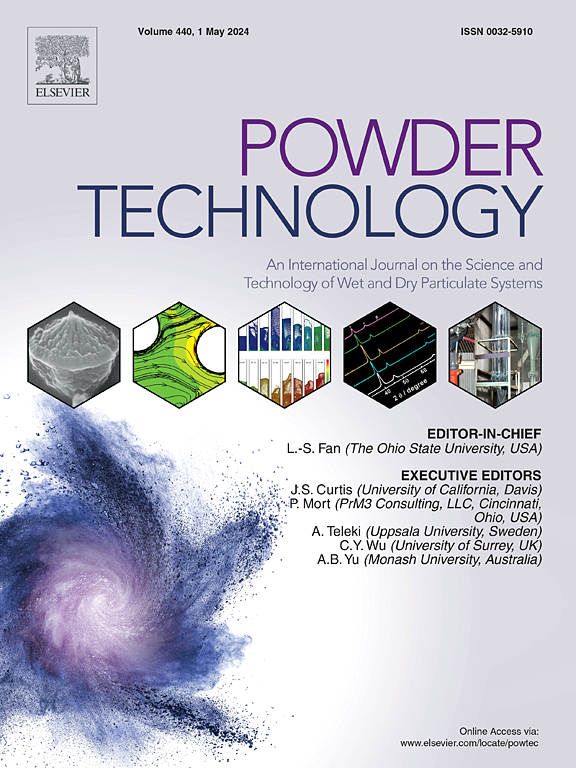Numerical study on startup behaviors of dense powder conveying in powder fueled ramjets using modified TFM incorporated with μ(I) rheology theory
IF 4.5
2区 工程技术
Q2 ENGINEERING, CHEMICAL
引用次数: 0
Abstract
In-depth understandings of propellant conveying characteristics during startup stage are crucial for powder engine ignitions. A modified two-fluid model was presented for dense powder conveying in startup stage in this paper, in which the μ(I) rheology theory was implanted to replace kinetic theory of granular flow. New constructed model was employed to investigate the unsteady conveying characteristics, and three distinct sub-stages of dense powder conveying at startup stage and its competitive mechanisms were confirmed. In addition, the relative volatility was introduced to assess the effect of peak rate, and it was found that increases in the fluidizing gas pressure or the throat diameter were beneficial to the stability of conveying. This paper provides a new numerical approach for predicting the startup behaviors of dense powder conveying, and offers new insights into the dynamics of dense powder conveying and references for the development of reliable ignition technology in powder fueled ramjets.

结合μ(I)流变理论的改进TFM方法对粉末燃料冲压发动机中密粉输送启动行为的数值研究
深入了解启动阶段推进剂输送特性对粉末发动机点火至关重要。本文提出了一种改进的双流体模型,该模型以μ(I)流变性理论取代颗粒流动力学理论。采用新建立的模型对非定常输送特性进行了研究,确定了密粉输送启动阶段的三个不同子阶段及其竞争机理。此外,引入相对挥发性来评价峰值速率的影响,发现流化气体压力或喉部直径的增加有利于输送的稳定性。本文为致密粉末输送启动行为的预测提供了一种新的数值方法,为致密粉末输送动力学提供了新的认识,为粉末燃料冲压发动机可靠点火技术的开发提供了参考。
本文章由计算机程序翻译,如有差异,请以英文原文为准。
求助全文
约1分钟内获得全文
求助全文
来源期刊

Powder Technology
工程技术-工程:化工
CiteScore
9.90
自引率
15.40%
发文量
1047
审稿时长
46 days
期刊介绍:
Powder Technology is an International Journal on the Science and Technology of Wet and Dry Particulate Systems. Powder Technology publishes papers on all aspects of the formation of particles and their characterisation and on the study of systems containing particulate solids. No limitation is imposed on the size of the particles, which may range from nanometre scale, as in pigments or aerosols, to that of mined or quarried materials. The following list of topics is not intended to be comprehensive, but rather to indicate typical subjects which fall within the scope of the journal's interests:
Formation and synthesis of particles by precipitation and other methods.
Modification of particles by agglomeration, coating, comminution and attrition.
Characterisation of the size, shape, surface area, pore structure and strength of particles and agglomerates (including the origins and effects of inter particle forces).
Packing, failure, flow and permeability of assemblies of particles.
Particle-particle interactions and suspension rheology.
Handling and processing operations such as slurry flow, fluidization, pneumatic conveying.
Interactions between particles and their environment, including delivery of particulate products to the body.
Applications of particle technology in production of pharmaceuticals, chemicals, foods, pigments, structural, and functional materials and in environmental and energy related matters.
For materials-oriented contributions we are looking for articles revealing the effect of particle/powder characteristics (size, morphology and composition, in that order) on material performance or functionality and, ideally, comparison to any industrial standard.
 求助内容:
求助内容: 应助结果提醒方式:
应助结果提醒方式:


